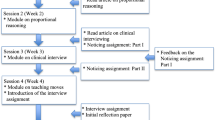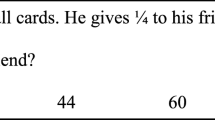Abstract
This study examined prospective teachers’ (PSTs) ability to recognize evidence of children’s conceptual understanding of mathematics in three content areas before and after an instructional intervention designed to support this ability. It also investigates the role PSTs’ content knowledge plays in their ability to recognize children’s mathematical understanding. Results of content knowledge assessments administered at the beginning of the study revealed that content knowledge did seem to support PSTs’ analyses of children’s understanding when the child’s response demonstrated understanding or demonstrated a misconception. Content knowledge did not seem to support PSTs’ analyses of children’s procedural responses, as many PSTs with good content knowledge initially characterized procedural solutions as evidence of conceptual understanding. Similarly, content knowledge did not seem to support PSTs’ analyses of children’s responses with features commonly associated with understanding but not evidence of understanding. After the instructional intervention consisting of three multifaceted lessons in which PSTs examined many examples of student thinking, they showed improved ability to analyze responses with conceptual features and no evidence of conceptual understanding and responses demonstrating procedural knowledge. Results suggest that content knowledge is not sufficient for supporting PSTs’ analysis of children’s thinking, and that building activities such as the intervention into content courses may help develop this ability. Implications for teacher education programs and future research are considered.


Similar content being viewed by others
Notes
We use “content knowledge” to refer to PSTs’ conceptual understanding of mathematics so as to be clear when we are talking about PSTs’ conceptual understanding versus the conceptual understanding of children.
References
Annenberg Media. (2007). Place value centers. Retrieved October 1, 2010, from http://www.learner.org/resources/series32.html.
Ball, D., Bass, H., Sleep, L., & Thames, M. (2005, May). A theory of mathematical knowledge for teaching. Paper prepared for work session at the 15th ICMI study conference. Aguas de Lindoia, Brazil: The Professional Education and Development of Teachers of Mathematics.
Ball, D. L., Hill, H. C., & Bass, H. (2005). Knowing mathematics for teaching: Who knows mathematics well enough to teach third grade, and how can we decide? American Educator, 29(3), 14–22, 43–46.
Barlow, A. T., & Drake, J. M. (2008). Division by a fraction: Assessing understanding through problem writing. Teaching Children Mathematics, 13, 326–332.
English, L. D. (1998). Children’s problem posing within formal contexts and informal contexts. Journal for Research in Mathematics Education, 29, 83–106.
Glaser, B. G., & Strauss, A. L. (1967). The discovery of grounded theory: Strategies for qualitative research. Chicago: Aldine.
Hiebert, J., Carpenter, T. P., Fennema, E., Fuson, K. C., Wearne, D., Murray, H., et al. (1997). Making sense: Teaching and learning mathematics with understanding. Portsmouth, NH: Heinemann.
Hiebert, J., & Lefevre, P. (1986). Conceptual and procedural knowledge in mathematics: An introductory analysis. In J. Hiebert (Ed.), Conceptual and procedural knowledge: The case of mathematics (pp. 1–27). Hillsdale, NJ: Lawrence Erlbaum.
Hiebert, J., Morris, A. K., Berk, D., & Jansen, A. (2007). Preparing teachers to learn from teaching. Journal of Teacher Education, 58, 47–61.
Jacobs, V. R., & Philipp, R. A. (2004). Mathematical thinking: Helping prospective and practicing teachers focus. Teaching Children Mathematics, 11, 194–201.
Jansen, A., & Spitzer, S. M. (2009). Prospective middle school mathematics teachers’ reflective thinking skills: Descriptions of their students’ thinking and interpretations of their teaching. Journal of Mathematics Teacher Education, 12(2), 133–151.
Luo, F. (2009). Evaluating the effectiveness and insights of pre-service elementary teachers’ abilities to construct word problems for fraction multiplication. Journal of Mathematics Education, 2(1), 83–98.
Morris, A. K. (2006). Assessing pre-service teachers’ skills for analyzing teaching. Journal of Mathematics Teacher Education, 9(5), 471–505.
National Council of Teachers of Mathematics. (2000). Principles and standards of school mathematics. Reston, VA: NCTM.
National Research Council. (2001). Adding it up: Helping children learn mathematics. Washington, DC: National Academy Press.
Philipp, R. A. (2008). Motivating prospective elementary school teachers to learn mathematics by focusing upon children’s mathematical thinking. Issues in Teacher Education, 27(2), 195–210.
Philipp, R. A., & Cabral, C. P. (2005). IMAP: Integrating mathematics and pedagogy to illustrate children’s reasoning. San Diego, CA: San Diego State University Foundation.
Putnam, R. T., Heaton, R. M., Prawat, R. S., & Remillard, J. (1992). Teaching mathematics for understanding: Discussing case studies of four fifth-grade teachers. Elementary School Journal, 93(2), 213–228.
Spitzer, S. M., Phelps, C. M., Beyers, J. E. R., Johnson, D. Y., & Sieminski, E. M. (2011). Developing prospective elementary teachers’ abilities to identify evidence of student mathematical achievement. Journal of Mathematics Teacher Education, 14(1), 67–87.
Thompson, A. G., Philipp, R. A., Thompson, P. W., & Boyd, B. A. (1994). Calculational and conceptual orientations in teaching mathematics. In A. Coxford (Ed.), 1994 Yearbook of the NCTM (pp. 79–92). Reston, VA: NCTM.
Acknowledgments
This research was supported by a grant from the National Science Foundation (Grant 0083429 to the Mid-Atlantic Center for Teaching and Learning Mathematics). The views expressed are those of the authors and not necessarily those of the Foundation. We would like to thank Sandy Spitzer and Christine Phelps for their comments regarding early ideas for the design of this study.
Author information
Authors and Affiliations
Corresponding author
Rights and permissions
About this article
Cite this article
Bartell, T.G., Webel, C., Bowen, B. et al. Prospective teacher learning: recognizing evidence of conceptual understanding. J Math Teacher Educ 16, 57–79 (2013). https://doi.org/10.1007/s10857-012-9205-4
Published:
Issue Date:
DOI: https://doi.org/10.1007/s10857-012-9205-4




